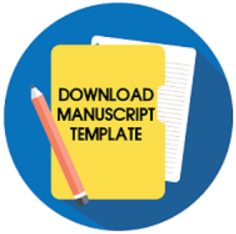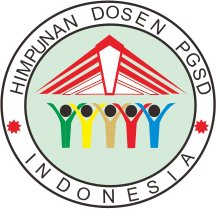STEM Learning Design with Literation-Based Pop-Up Book Media in Elementary Schools
Downloads
This study aims to examine the stages of developing a STEM learning design with literacy-based Pop-Up Book media. Media-integrated instructional designs can facilitate students' mastery of the studied subject. The implementation of learning designs with creative media has not been widely applied during teaching and learning activities in class, especially in thematic learning with the 2013 curriculum. Pop-Up Book Media is creative media applied to literacy-based STEM learning designs in school. This study used a design-based research method. Data were collected through interviews, expert assessments, and questionnaires. Pop-Up Book media based on literacy has been designed to be implemented through STEM learning designs in elementary schools. Therefore this creative media can be applied by teachers in learning with the 2013 curriculum in elementary schools.
Downloads
Aji, I. A., & Pujiastuti, P. (2021). Development of natural science supplement books based on local wisdom in integrative thematic learning in the elementary schools. Jurnal Prima Edukasia, 10(1), 82-95. http://dx.doi.org/10.21831/jpe.v10i1.40173
Aningsih, A., & Sapitri, I. (2018). Application of the inquiry learning model to increase the activeness and learning outcomes of students in science lessons on material materials and their properties in grade iii padurenan 04 elementary school bekasi. Pedagogik: Jurnal Pendidikan Guru Sekolah Dasar, 6(1), 50-58. https://www.jurnal.unismabekasi.ac.id/index.php/pedagogik/article/view/437/340
Artobatama, I. 2018. Outbound stem-based learning traditional games. Jurnal Prima Edukasia, 2(2), 40-4. https://doi.org/10.17509/Ijpe.V2i2.15099
Artobatama, I., Hamdu, G., & Rosarina. G. (2020). STEM learning design analysis based on 4c capability in elementary school. Indonesian Journal of Primary Education, 4(1), 76-86. https://doi.org/10.17509/ijpe.v4i1.24530
Barab, S. (2006). Design-based research: A methodological toolkit for the learning scientist. Cambridge.
Cresswell, J. W., Plano-Clark, V. L., Gutmann, M. L., & Hanson, W. E. (2003). Advanced mixed methods research designs. Handbook of Mixed Methods in Social and Behavioral Research.
Dayu, D. P., & Setyaningsih, N. D. (2022). Big book to increase 5th grade students' reading literacy. Jurnal Prima Edukasia, 10(1), 1-8. http://dx.doi.org/10.21831/jpe.v10i1.41115
Dindin, A. M. L. (2012). Lesson study as innovation for improving education quality. Direktori File UPI.
Dong, Y., Wang, J., Yang, Y., & Kurup, P. M. (2020). Understanding intrinsic challenges to STEM instructional practices for Chinese teachers based on their beliefs and knowledge base. International Journal of STEM Education, 7(1), 1-12. https://doi.org/10.1186/s40594-02000245-0.
Falentina, C. T. (2018). Wind-powered car: Stem-based media for fourth grade elementary school students. Pedadidaktika: Jurnal Ilmiah Pendidikan Guru Sekolah Dasar, 5(3), 152-162. http://dx.doi.org/10.23887/ijee.v4i2.25205
Grí¶sser, S.N. (2013). Research Design. In: Co-Evolution of Standards in Innovation Systems. Contributions to Management Science. Physica, Heidelberg. https://doi.org/10.1007/978-3-7908-2858-0_3
Haryati, T., Lidinillah, D. A. M., & Karlimah, K. (2020). Development of stem learning design in the 2013 curriculum in elementary schools: An analysis and exploration. Didaktika: Jurnal Pendidikan Sekolah Dasar, 3(2), 71-78. http://dx.doi.org/10.21831/didaktika.v3i2.33303.
Herak, M. (2011). Cubic magnetic anisotropy of the antiferromagnetically ordered Cu 3TeO6. Solid State Communications. https://doi.org/10.1016/j.ssc.2011.07.024
Istiningsih, S., Widari, N. K. S., & Hasanah, N. (2018). The effectiveness of the fish bowl or aquarium technique to improve social studies learning outcomes in class va students at cakranegara 16 elementary school in the 2016/2017 academic year. JKKP (Jurnal Kesejahteraan Keluarga dan Pendidikan), 5(1), 82-94. https://doi.org/10.21009/jkkp.051.08
Kelley, T. R., & Knowles, J. G. (2016). A conceptual framework for integrated STEM education. In International Journal of STEM Education. https://doi.org/10.1186/s40594-016-0046-z
Kuenzi, M., & Schminke, M. (2009). Assembling fragments into a lens: A review, critique, and proposed research agenda for the organizational work climate literature. Journal of management, 35(3), 634-717. https://doi.org/10.1177/0149206308330559
McKenney, S., & Reeves, T. C. (2013). Systematic review of design-based research progress: Is a little knowledge a dangerous thing? Educational researcher, 42(2), 97-100. https://doi.org/10.3102/0013189x12463781
Nawangsari, N. S., Pujiastuti, P., & Gularso, D. (2022). The effect of project-based learning model on PGSD students' critical thinking skill. Jurnal Prima Edukasia, 10(1), 19-27. http://dx.doi.org/10.21831/jpe.v10i1.41565
Patricia, F. A., & Zamzam, K. F. (2021). Development of scientific approach-based interactive multimedia for elementary school dyscalculia children. Jurnal Prima Edukasia, 9(1), 32-43. http://dx.doi.org/10.21831/jpe.v9i1.33853
Rahayu, E. W., & Mustadi, A. (2022). The read-aloud method to develop reading literacy at school's educational park. Jurnal Prima Edukasia, 10(2), 104-113. http://dx.doi.org/10.21831/jpe.v10i2.47331
Reeves, T. (2009, December). The application of "design research" to e-learning. In the First International Conference for e-Learning and Distance Learning. Retrieved from www. eli. elc. edu. sa/2009/content/Reeves [research]. pdf.
Roehrig, G. H., Dare, E. A., Ring-Whalen, E., & Wieselmann, J. R. (2021). Understanding coherence and integration in integrated STEM curriculum. International Journal of STEM Education, 8, 1-21. https://doi.org/10.1186/s40594-020-00259-8
Santoso, M. R., & Yang, P. C. (2016). Magnetic nanoparticles for targeting and imaging of stem cells in myocardial infarction. Stem cells international, 2016. https://doi.org/10.1155/2016/4198790
Saputra, R. A., Herpratiwi, H., & Caswita, C. (2020). Developing a STEM-based students' worksheet building material in elementary school Bandar Lampung City. Jurnal Prima Edukasia, 8(2), 145-155. http://dx.doi.org/10.21831/jpe.v8i2.33478
Seeto, D., & Herrington, J. (2006). Design-based research and the learning designer. Ascilite 2006 - The Australasian Society for Computers in Learning in Tertiary Education.
Sugiyono, D. (2013). Educational research methods with quantitative, qualitative and R&D approaches. Alfabeta.
Triwahyuningtyas, D., Ningtyas, A. S., & Rahayu, S. (2020). The problem-based learning e-module of planes using Kvisoft Flipbook Maker for elementary school students. Jurnal Prima Edukasia, 8(2), 199-208. http://dx.doi.org/10.21831/jpe.v8i2.34446
Tsupros, N., Kohler, R., & J.Hallinen. (2009). STEM education: A project to identify the missing components. Intermediate Unit 1 and Carnegie Mellon.
Utami, D. W., Anwar, M., & Hermawan, H. (2018). The effect of using the assure learning model on increasing science learning achievement for children with class iv tunalaras at Bhina Putera special school Surakarta academic year 2017/2018. JPI (Jurnal Pendidikan Inklusi), 2(1), 5-14. https://doi.org/10.26740/inklusi.v2n1.p5-14
The copyright of the received article shall be assigned to the journal as the publisher of the journal. The intended copyright includes the right to publish the article in various forms (including reprints). The journal maintains the publishing rights to the published articles.

Jurnal Prima Edukasia by http://journal.uny.ac.id/index.php/jpe/index is licensed under a Creative Commons Attribution-ShareAlike 4.0 International License.


























